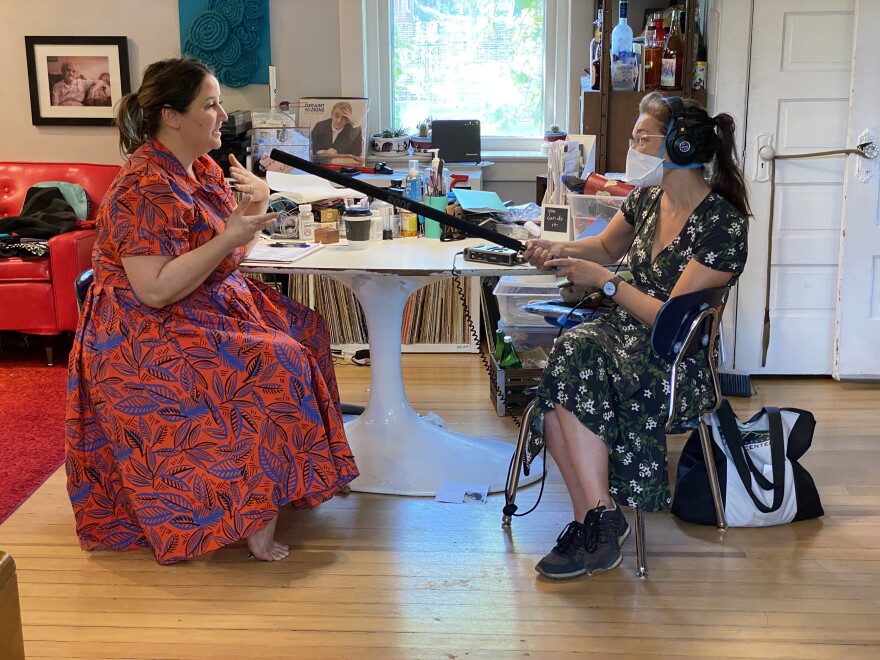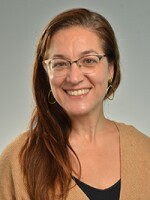For more stories like this one, subscribe to Real Humans on Apple Podcasts, Spotify, Stitcher or wherever you get podcasts.
The first time I heard the song "Thrice All American" by Neko Case, the simple opening line commanded my full attention.
"I wanna tell you about my hometown."
Case doesn’t state her intention gently or wistfully. She howls with urgency.
"Thrice All American" goes on to paint a complicated picture of Tacoma, Washington, an industrial town overlooked by outsiders who don’t see in it what Case does. Outsiders observe abandoned buildings; Case breathes life into them.
I’m not from Tacoma, but I've loved this song for as long as I've been a journalist. I recognized in it something that’s fueled my work for and about Kansas City: this pressing need to tell people what it feels like to be from here.
Not as a generic Kansas Citian — no such person exists — but as myself. I’m not trying to tell outsiders about us. I’m telling us about us.
I was born here in 1977. But I didn’t fall in love with Kansas City right away. That didn’t really happen until my first summer home from college in the 1990s.
Up until that point, I’d lived in Kansas City the way a child does: going where I was supposed to go, seeing what I was supposed to see.
My parents weren’t native Kansas Citians. My dad came from Chicago by way of an air force base in Japan, where a fellow service member extolled the virtues of this fabled city of fountains. My mom grew up moving back and forth between Chicago and Los Angeles, landed in Columbia, Missouri, to study ceramics, then jumped over to Kansas City after a couple of years.
When they arrived, my parents followed cues from locals about where to go and how to live. In a city shaped by segregation, that resulted in a lot of stifling sameness.
Neither of the transplants who raised me exhibited the restraint for which Kansas Citians are known. My dad spoke bluntly; my mom's fashion sense included purple leather pantsuits and lots of hairspray. Both of them had a way of unsettling the air around them, which I observed. And both openly expressed puzzlement at the whiteness of the Kansas City we lived in.
I was an insider raised by outsiders, seeing Kansas City through their eyes as much as my own. And by my teenage years, I wanted to escape Kansas City with a contempt I now find embarrassing, even though familiarity so often breeds just that.
I didn’t understand why I was bored, only that I was bored. In typical teenage fashion, however, I thought it was about the city itself, rather than the way I'd been living in it.
Which is to say, there was a whole lot more to Kansas City. I just didn't know it yet.

When I left Kansas City for New York at 18, my parents marveled at how unsentimentally I boarded the plane, not even a teensy last glance over my shoulder. I didn’t realize, until they pointed it out, that I was supposed to feel nostalgic. I was absolutely thrilled to leave.
When I came back for the summer, though, I took a job at a quirky indie movie theater in Westport — Tivoli Cinemas, RIP — and from that vantage point, I started seeing a different Kansas City.
It wasn’t Westport itself that was new to me; I’d hung out in coffee shops and record stores there since high school. It was the friends I made. They spoke with ever-so-slight twangs and left the "g" off "ing" words. Did people from Kansas City talk that way? I'd never heard it before — I thought all Kansas Citians spoke like I did.
Some part of me began to recognize how little I knew my own hometown. And where boredom once lurked, curiosity took over.
With every plane I boarded back to school for the next three years, the looks over my shoulder grew longer and less certain.
This is basically the story of how I became a journalist, even if it doesn't sound that way. I moved back to Kansas City after graduation, with a notebook in my hand.
I'd been a French major, which has no real career outcome, but it does fill one's head with a lot of pretentious and highly quotable philosophy. One of those ideas I quickly attached to Kansas City was Blaise Pascal's theory that we live between two infinities: the infinitely large and the infinitely small.
The universe out there is the big infinity. It's measured in miles, in vast expanses. It's the infinity of the telescope. The smaller infinity is the infinity of detail. It's the infinity of the microscope. It's the infinity of every human being's inner world.
New York, for me, had been the big infinity. Kansas City was a smaller infinity. And in many ways, a greater mystery.
My reporter's notebook was my microscope, and also my permission slip.
Kansas City is diverse — in every way imaginable. But if you live here according to well-worn patterns, you will probably look around and see people who look like you, hearing stories that sound a lot like the ones you already know.
That's a vestige of segregation, etched into this landscape by urban design, then given a kind of permanence by force of habit.
Technically, you don't need permission to transgress unspoken boundaries in a city, to ask questions that aren't polite, to disobey the informal codes that enforce and reinforce the sense of sameness I'd wanted to flee.
But a little notebook can make a big difference. Talking to people across invisible lines became my vocation, but I've never really gone anywhere just for journalism, and I've never really asked my questions just for journalism, either.
I've been genuinely trying to understand this place, one person at a time.

When I say that I want to tell you about my hometown? I want to know about it, too. I want us all to tell each other. It's how those boundaries start breaking down. It's how this place gets interesting. And it's also how we heal.
After nearly two years writing this Real Humans column and podcast, next week will be the final installment. But first, I have just a few things I want to say to you, Kansas City.
You have the best porch-sitting in a storm. And also not in a storm.
You have the best horizon line between buildings. In some cities, you need to get out of the thick of it to see a horizon, but it's always visible here, and that's beautiful.
(Of course, that's because you went all-in on surface parking. When I talked to him in 2004, artist Jim Woodfill giddily called them "viewports" for the scenic opportunities they created. And sure, it's kind of a bummer that you gave up urban density for cement lots, but I won't complain about seeing the horizon. It's a small joy you've given me.)
I love your weird obsession with dancing water displays in fountains, set to music. My favorite choreographed fountain show is the one at Kauffman Stadium, but I also appreciate the less-celebrated display at Crown Center.
I also want to tell you what it's like to sit face to face with an Indigenous woman, looking her squarely in the eye while hearing her describe how stereotyping has harmed her community, and then to see your football fans downplay and excuse the racism of the Tomahawk chop and the team name that adorns the town.
I want to tell you that, but I suspect, deep down, that you already know.
I'm not proud of your Pendergast-era mob bosses, either, no matter how cool their hats and cars were. Nor do I understand why we glorify their memory. You do know that the Union Station Massacre was mass murder, right?
I've discovered so many other Kansas City claims to fame, though, that do make me proud, and I want people to start bragging about those instead.
Like, the fact that three years before the Stonewall uprising in Greenwich Village — marking a turning point in the fight for LGBTQ rights in the United States — a meeting in Kansas City laid the groundwork for the movement. "It was the first ever gathering of gay and lesbian civil rights leaders from different organizations across the country," Stuart Hinds told me in 2018.
Kansas City, you sure do keep your secrets.
I love that strawberry soda is on tap in nearly all your barbecue joints, and that french fries at Winstead's sometimes come with a lone tater tot.
It's completely bonkers that you have hundreds of millions of pounds of cheese sitting in a network of underground caves known as a subtropolis. But knowing that it's there gives me immense personal satisfaction.
Same with the sunken steamboats that keep emerging from underneath cornfields outside of town.
I love your neighborhoods: the Keebler elf houses of Waldo; the quaint tyranny of passing trains in the East and West Bottoms (also, the fact that you have not one but two neighborhoods called "Bottoms" to begin with); the unexplained presence of three consecutive side streets with women's first names in Pendleton Heights — Minnie, Elma and Amie.
Kansas City, thank you for never asking — right off the bat when you meet someone new — "what do you do?"

Speaking of which:
In case you didn't do the math when I mentioned my birth year, I'm about to turn 45. If I'm lucky, I still have about half of my career to go.
Kansas City has given me an infinity of a kind. But I have other questions to explore, whole new geographies to attempt to understand.
I'm a mother finding my footing in a pandemic that left me and my child clinging to one another, in a private world of our own, for safety. Having parented in survival mode, I now want to experience motherhood in other ways. More ways, in fact, than I'd been able to fully enjoy before as a juggler of career and household obligations.
I went into the pandemic seeing myself as young. I don't see myself that way now. So I get to figure out how to age. Which is a privilege.
I won't stop writing. But I'll be fitting it into my life instead of the other way around. I have a notebook. But it's not my permission slip. It's my calling.
After two years creating Real Humans — and many more years at this station — next week will be my last installment. I want to end with lessons I've learned from all the Real Humans I've had the honor of meeting.
But then, I hope Kansas Citians keep seeking out the real humans who surround them every day.
Take a notebook. It's amazing what people will tell you if you ask.







